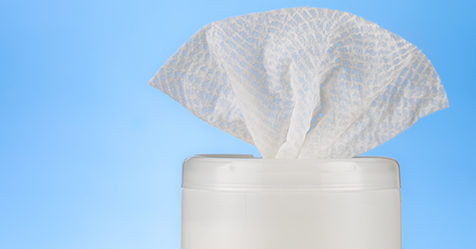Purchasing new equipment is about more than wanting new “toys.” It’s about fostering your business’ growth and development.
Given the very labor intensive and hands-on nature of the cleaning industry, it’s easy to overlook how developments in technology can affect your organization. Now, I have nothing against traditional tools. However, it’s important to step back and remember that outdated and cheap equipment can be the most expensive choice you’ll ever make. Let’s examine how spending some of that hard-earned money can increase your bottom line.
No. 1: Productivity
Using the right tool for the job goes a long way toward improving cleaning efficiency. For example, most commercial, upright vacuum cleaners come with a standard 12-inch cleaning width, weigh 30 pounds, and, according to ISSA’s 612 Cleaning Times, clean roughly 2,239 square feet per hour. However, wouldn’t it be better to clean 7,273 square feet per hour—more than three times the amount of ground you can cover with an upright vacuum? A backpack vacuum may give you this productivity. With this in mind, you may want to consider moving to a canister or preferably a backpack vacuum cleaner. While the initial drawback is cost, it is easily offset by the enormous labor/cost benefits.
In an industry where time is money, it’s necessary to take advantage of technological advancements that decrease labor time and difficulty. For example, one worker with a backpack vacuum can clean a commercial office space in the same amount of time as three cleaners with upright vacuums. By purchasing the backpack vacuum, the other two workers’ hourly wages can fall off your payroll, and instead, turn into profit or go toward other necessary expenditures. Furthermore, the average lifespan of backpack vacuums is 3–5 years, which means you save the equivalent of two additional salaries for the entire life of those vacuums.
The additional advantages of purchasing more mobile and efficient equipment are especially evident if your company services multistory buildings, health care clients, or facilities with wide corridors. In these situations, their value cannot be overstated.
No. 2: Sustainability
The goal of truly sustainable cleaning is to get the job done effectively and thoroughly while using practices that minimize negative environmental impacts. This trend is not only beneficial to human health and the environment, but also to profits as customers continue to drive the market towards greener alternatives. Gone are the days when customers were okay with harmful toxins, chemicals, and resource waste; today customers are more environmentally and socially conscious, so showing that your business uses sustainable practices goes a long way. New equipment that supports this mindset can help.
Take, for instance, the positive impact auto scrubbers can have on water and energy consumption. Especially in regions where water conservation is critical, auto scrubbers can help meet this challenge. Some of these machines can reuse water by filtering out dirt and debris larger than 5 microns, which is more sustainable than using a traditional mop and bucket.
For example, a mop will contaminate the contents of a bucket before you are able to use all the water, requiring frequent changing. If you dump out a 25-gallon bucket four times while mopping, you’ve used 100 gallons. With an auto scrubber, you don’t have to constantly change out the water, which in turn, saves water. In addition, organizations can claim the cost of particular auto scrubbers against taxable profits, which means sustainable behavior can save money. In order to take advantage of this benefit, the scrubber must be on the U.S. Government’s Water Technology List.
Nearly all modern auto scrubbers are equipped with rechargeable batteries. This has two major sustainability benefits. The first is that batteries are recyclable, which has very apparent, tangible benefits for the environment. The second is that rechargeable batteries, especially the large, lithium-ion batteries found in scrubbers, last longer than normal batteries. Therefore, instead of disposing of several batteries, you just have to replace your lithium-ion battery approximately every 2–3 years. This not only promotes sustainability, but it saves money
in the long-term.
No. 3: Professionalism
It’s said that one should dress for success when working or attending a job interview; you shouldn’t treat your business any differently. Looking professional, organized, and qualified are the keys to long-term success, brand recognition, and ultimately, great profitability. Having a cleaning business or facilities management department that runs efficiently and professionally can help to push your cleaning contract or budget agenda through an organization’s corner office. There are a couple tips to unlocking this professionalism, and they involve using the latest technology.
Modern business software allows you to manage work tickets and jobs, perform inspections, review invoices, see employee information, submit inventory requests, review timekeeping, collect and analyze data on your performance, and create professional-looking proposals and bids. If you are a building service contractor, software also enables you to make more accurate (profitable), data-driven bids and will not only create an air of expertise, but break down exactly how the bid amount was reached. For facility managers, this data can help with defending your budget when trying to improve upon or justify equipment or staffing needs. Giving your employer or supervisor confidence and peace-of-mind by being transparent about costs will not only add an air of professionalism, but also boost your reputation by demonstrating your trustworthiness. For these reasons, it may be time to upgrade your workloading solutions.
It’s All About Perception
For centuries, custodial care has been someone’s job in most places of work. But while our tools have remained static throughout much of the last 100 years, outside pressures on our industry have continued to change: Workers’ compensation, labor rates, taxes, and costs for paper and supplies have all seen increases. Simultaneously, budget pressures have continued to increase, and in return, we have had to make the best use of our resources.
Although the previous century experienced few technology changes for the custodial industry, technology in the last 25 years has grown by leaps and bounds, with the most recent 5 years showing an impressive revitalization in new thinking. As a result, organizations are seeing new opportunities to improve production rates and cleaning results. These opportunities may require some investment upfront, but sometimes, money spent can easily turn into money saved or money earned.
Three Tips for Increasing Your Return on investment
By Kathleen Misovic, CMM assistant editor
Robotic floor scrubbers are becoming more common as building managers purchase them to help streamline their facilities’ floor cleaning process. How can you guarantee a return on investment for this purchase? Experts offer three tips:
1. Take Advantage of Parallel Cleaning Capabilities
Robotic floor scrubbers allow cleaners to make better use of their time by avoiding monotonous tasks. Floor cleaning is a time-intensive process that involves pre-sweeping, spot cleaning, and edge mopping, among other pre-scrubbing tasks, explains Paul Behnke, director of marketing at Brain Corp., a software company specializing in the development of intelligent, autonomous systems.
Custodians can perform these tasks on one section of the floor, then set up the robotic cleaner to do the final scrubbing as they perform pre-scrubbing tasks on the rest of the floor. Another option is to perform other high-value tasks, such as picking up trash and cleaning offices, while the floor scrubber does its job.
2. Program Systems to Clean in Sections
Temporarily closing pathways for floor cleaning is difficult in facilities that are busy 24/7, such as hospitals. Robotic floor scrubbers can be programmed to follow specific routes in particular building areas at certain times, so you can arrange the scrubbers to accommodate the hours with the highest foot traffic.
3. Implement Staff Training
The best autonomous system won’t save your crew time if they don’t know how to use it effectively. Companies are no longer plopping their cleaning team in front of an instructional video or DVD for training, since the knowledge retention rate from this method is low.




